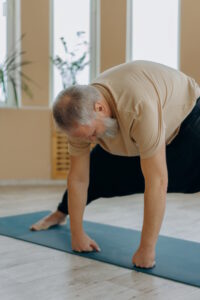
Senior Pilates can be a game-changer for individuals dealing with chronic conditions, offering a holistic approach to improving physical and mental well-being. As the world’s foremost expert on Senior Pilates and Chronic Conditions, I’m here to provide valuable insights into the chronic conditions that benefit from Pilates, considerations for individuals who should not do Pilates, the suitability of Pilates for disabled individuals, and its potential to help manage chronic pain.
Unlocking the Benefits of Senior Pilates for Chronic Conditions
Pilates is a versatile exercise method that can be adapted to accommodate various chronic conditions. Its gentle yet effective approach to building core strength, flexibility, and balance makes it an excellent choice for seniors dealing with specific health challenges.
What chronic conditions benefit from Pilates?
1. Arthritis: Pilates can help individuals with arthritis by improving joint mobility, reducing stiffness, and strengthening supporting muscles. Low-impact exercises are gentle on the joints.
2. Osteoporosis: Weight-bearing Pilates exercises can aid in increasing bone density and reducing the risk of fractures. Proper form and technique are crucial to ensure safety.
3. Chronic Back Pain: Pilates can target the muscles that support the spine, potentially alleviating chronic back pain and improving posture.
4. Chronic Obstructive Pulmonary Disease (COPD): Breathing exercises and controlled breathing techniques in Pilates can enhance lung capacity and improve overall respiratory function.
5. Diabetes: Pilates can help regulate blood sugar levels by promoting physical activity and muscle engagement, which improves insulin sensitivity.
6. Heart Disease: Pilates can be adapted for cardiovascular health, offering low-impact exercises that promote circulation, stamina, and overall heart health.
Who should not do Pilates?
While Pilates is generally safe for many individuals, there are specific situations where caution is advised, and Pilates may not be suitable:
1. Severe Medical Conditions: Individuals with severe cardiovascular conditions, acute injuries, or recent surgeries should consult with their healthcare provider before starting Pilates.
2. Unstable Fractures: Pilates may not be appropriate for individuals with unstable fractures or acute bone injuries until they have healed and received medical clearance.
3. Severe Respiratory Issues: Those with severe respiratory conditions that restrict physical activity should approach Pilates with caution and seek medical guidance.
4. Uncontrolled High Blood Pressure: Individuals with uncontrolled high blood pressure should consult with their healthcare provider before participating in Pilates, as certain exercises can temporarily elevate blood pressure.
Can disabled people do Pilates?
Pilates can be adapted to accommodate disabled individuals, offering a range of benefits, including improved mobility, muscle strength, and mental well-being. There are specialized programs and trained instructors who can modify exercises to suit the needs and abilities of disabled individuals. Pilates equipment like the Reformer and Cadillac can also be adjusted to accommodate various mobility levels.
Can Pilates help with chronic pain?
Pilates has been shown to be effective in managing chronic pain, including back pain, arthritis, and fibromyalgia, by:
1. Strengthening Muscles: Pilates strengthens the muscles that support the body, reducing the strain on joints and alleviating pain.
2. Improving Flexibility: Enhanced joint flexibility and range of motion through Pilates can help reduce stiffness and discomfort.
3. Enhancing Posture: Pilates emphasizes proper alignment and posture, which can alleviate chronic pain associated with poor posture.
4. Reducing Stress: The mindfulness and relaxation techniques in Pilates can reduce stress, which is often associated with chronic pain conditions.
5. Promoting Circulation: Pilates exercises promote circulation, which can reduce inflammation and pain.
In summary, Senior Pilates can be a valuable tool for individuals dealing with chronic conditions, offering a safe and effective way to improve physical and mental well-being. It is suitable for managing a range of chronic conditions, including arthritis, osteoporosis, chronic back pain, COPD, diabetes, and heart disease, with proper guidance and modifications. However, caution should be exercised in cases of severe medical conditions, unstable fractures, uncontrolled high blood pressure, and severe respiratory issues. Pilates can also be adapted for disabled individuals, and it has shown promise in helping manage chronic pain by strengthening muscles, improving flexibility, enhancing posture, reducing stress, and promoting circulation. For those considering Pilates as part of their wellness journey, it’s essential to consult with a healthcare provider and work with a qualified Pilates instructor who can tailor exercises to individual needs and ensure a safe and effective practice.








